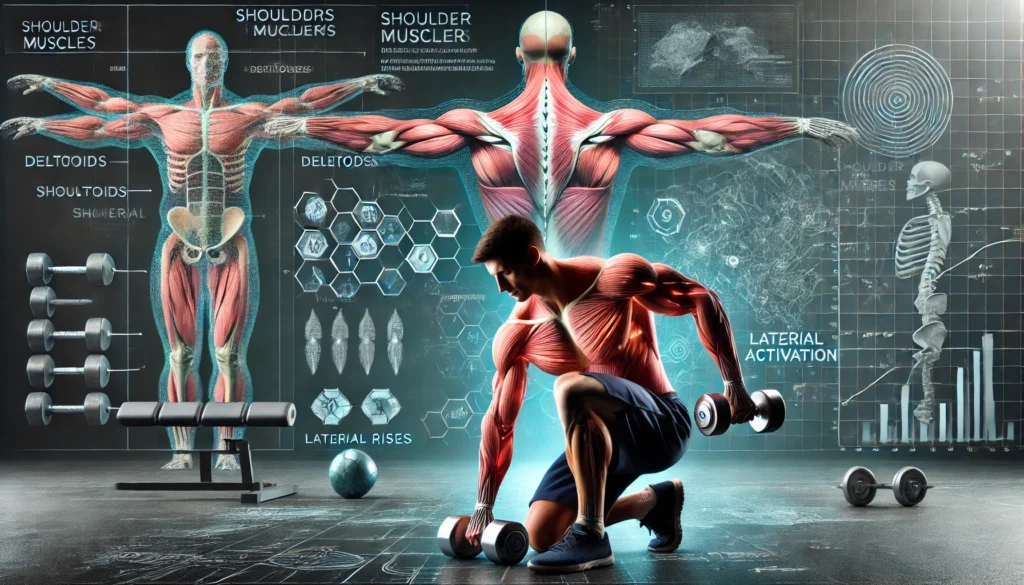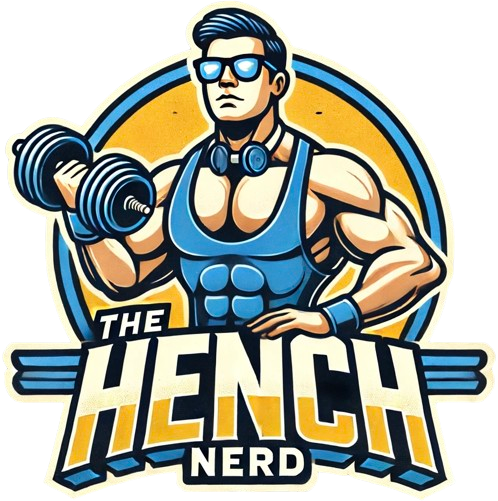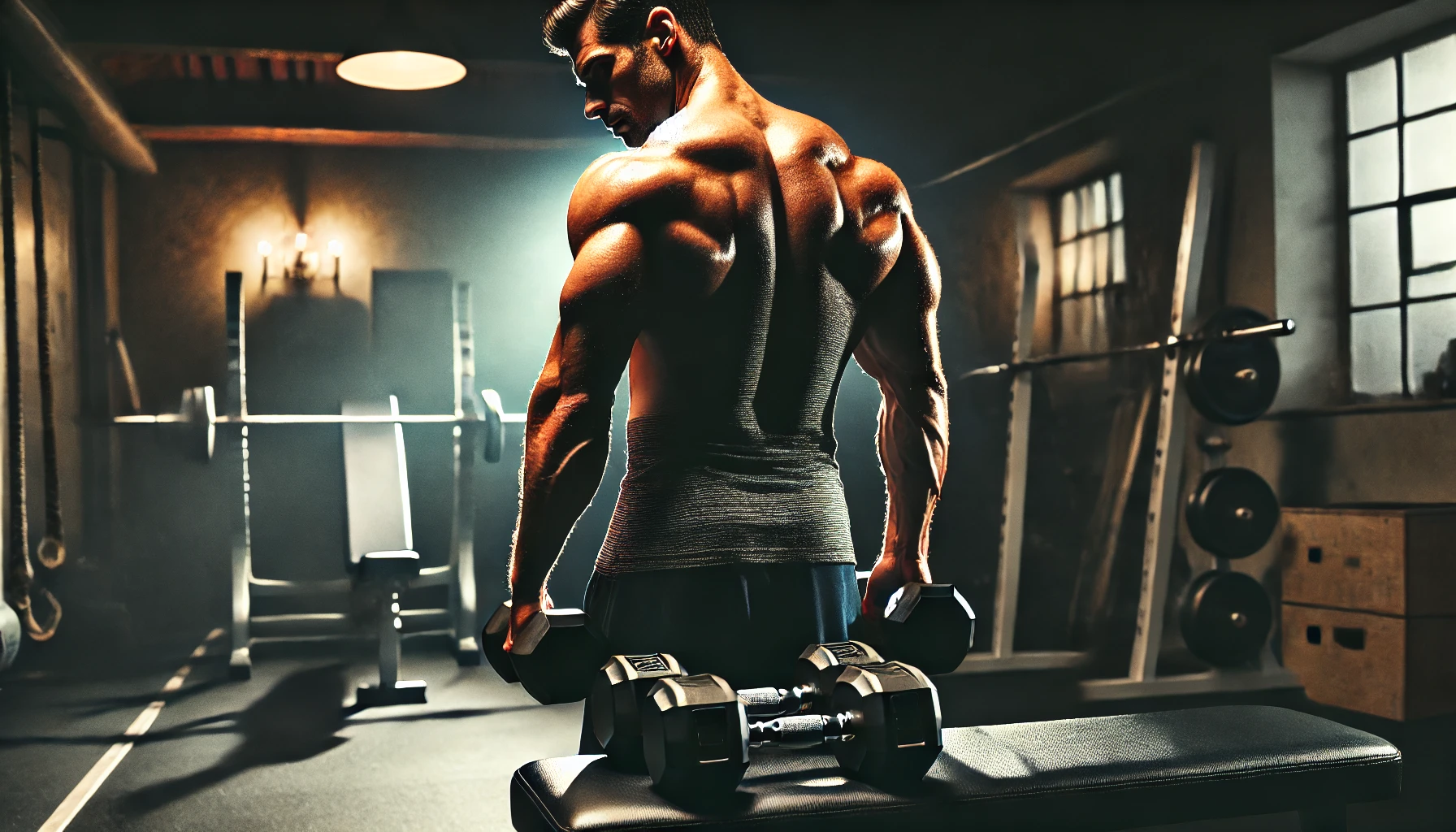Welcome to the ultimate guide for building strong, defined shoulders using nothing but a pair of dumbbells. For men over 40 looking to get the most out of their shoulder workouts at home, this comprehensive guide will show you how to sculpt impressive shoulders without the need for fancy equipment or gym memberships.
There’s a lot of conflicting advice out there when it comes to shoulder exercises with dumbbells. Many routines complicate things with endless variations and promises of results. But the reality is, all you need are a few effective movements performed with good form and intensity. In fact, for an effective shoulder workout with dumbbells and a bench, you only need two key exercises.
I’ve personally spent months relying on getting strong and ripped at home , and my shoulder development didn’t suffer one bit. My favourite exercise has always been the seated dumbbell shoulder press. It’s straightforward and incredibly effective, allowing me to target all three heads of the shoulder for balanced growth. Similarly, the standing dumbbell lateral raise isolates the side delts perfectly, adding width and roundness to your shoulders. Let’s break down these two essential exercises, their benefits, and how to get the most out of them.
The Benefits of Dumbbells for Shoulder Workouts at Home
Why are dumbbells such a great tool for training shoulders? Let’s look at some key benefits:
1. Greater Range of Motion
Unlike machines or barbells, dumbbells allow for a greater range of motion. This means you can get a deeper stretch and a more complete contraction in each rep. This is crucial for shoulder development, as the increased range of motion leads to better activation of the deltoid muscles.
2. Enhanced Muscle Activation
With dumbbells, you’re forced to stabilise the weight independently with each arm. This activates not only the main shoulder muscles but also the stabiliser muscles around the shoulder joint. This increased muscle activation leads to stronger and more resilient shoulders.
According to the European Journal of Applied Physiology, using dumbbells instead of barbells or machines requires greater stabilisation, resulting in increased recruitment of the deltoid muscle fibres, particularly in the anterior and lateral heads.”
— European Journal of Applied Physiology.
3. Balanced Development
One of the main advantages of using dumbbells is that they prevent the stronger side from compensating for the weaker side. This helps correct any imbalances and ensures balanced shoulder growth over time.
4. Convenience and Accessibility
A shoulder workout with dumbbells can be done anywhere, anytime. All you need is a pair of dumbbells and a bench or a sturdy chair. I’ve done this in my living room, garden, and even on the go when travelling. Dumbbells offer flexibility and allow you to train consistently without the need for a gym membership.
“To build strong, injury-resistant shoulders, it’s essential to include exercises that promote stability and balance. Dumbbell movements, due to their unilateral nature, are excellent for achieving this goal.”
— Dr. Mike Israetel, PhD, Sports Physiology and co-founder of Renaissance Periodization.
Muscle Growth: What Really Drives It?
Building muscle, whether it’s your shoulders or any other muscle group, is governed by a few key principles: progressive overload, intensity, and volume. Understanding these concepts is essential for maximising your results with any workout routine.
You don’t need a long list of shoulder exercises to get great results. Focus on mastering a few basic movements, progressively increase the weight, and you’ll see significant gains in size and strength.”
— Dr. James Steele, PhD, Exercise Physiology and Professor at Solent University.
Intensity vs. Volume: What’s More Important?
Muscle growth, or hypertrophy, occurs when your muscle fibres are broken down through resistance training and then repaired stronger and thicker than before. This process is primarily influenced by two factors: intensity and volume.
- Intensity refers to the level of effort exerted during a set, usually measured by how close you get to muscle failure. High-intensity training, where you perform each set to near failure, activates more muscle fibres and results in greater muscle growth.
- Volume is the total amount of work performed in a workout, calculated as sets x reps x weight. For hypertrophy, moderate volume with a focus on time under tension tends to work best.
Which is more important? Both play a role, but intensity is often the key driver of growth, particularly when training with dumbbells. Why? Because with dumbbell exercises, you can push each set to failure, ensuring maximum muscle activation. This is why I’ve always prioritised intensity over volume when using dumbbells for my shoulder workouts.
The Science Behind Shoulder Muscle Growth

Shoulder muscle growth is determined by the effectiveness of pressing and lateral raise movements. Exercises like the seated dumbbell shoulder press and standing dumbbell lateral raise are excellent for targeting all three heads of the deltoids: the anterior (front), lateral (side), and posterior (rear) deltoids.
Studies have shown that pressing movements with dumbbells engage the entire shoulder complex, promoting balanced growth and increased stability. This is because the pressing motion requires not only the main deltoid muscles but also the stabiliser muscles around the shoulder joint. The standing dumbbell lateral raise, on the other hand, is perfect for isolating the lateral deltoid, adding width and shape to the shoulders.
The Role of Nutrition and Rest in Muscle Growth
While progressive overload and proper exercise selection are essential for shoulder development, muscle growth won’t happen unless you pay attention to your nutrition and rest. A high-protein diet that supports muscle repair and growth is crucial, and it’s best to follow your calorie goal—whether that’s a surplus for building muscle or a deficit for getting lean. Aim for mostly healthy food choices for your carbs and fats, but don’t stress about the occasional treat.
Rest is just as important as nutrition. Muscles grow when you’re resting, not when you’re training. Ensure you’re getting adequate sleep and allowing your body time to recover between sessions. If your nutrition and rest are on point and you’re consistently progressing in your shoulder exercises with dumbbells, muscle growth is inevitable.
The Only Two Exercises You Need for an Effective Dumbbell Shoulder Workout
You don’t need a long list of exercises to build strong, well-developed shoulders. By focusing on these two essential movements, you’ll be able to target all areas of the shoulder for balanced development.
Seated Dumbbell Shoulder Press: The Ultimate Shoulder Builder
The seated dumbbell shoulder press is one of the most effective shoulder exercises with dumbbells. It targets the anterior and lateral deltoids, with additional activation of the triceps and upper chest. Performing this exercise seated helps eliminate momentum and ensures that your shoulders are doing all the work.
In a study published by the Journal of Sports Science, it was shown that performing compound movements like the seated dumbbell shoulder press not only strengthens the deltoids but also engages the triceps and upper chest, contributing to overall upper body development.”
— Journal of Sports Science.
- Targets All Areas of the Shoulders: Primarily the front and side delts, but also engages the stabiliser muscles around the shoulder joint.
- Builds Size and Strength: The pressing motion allows for heavier weights, leading to significant strength and size gains.
- Improves Stability and Balance: Each arm works independently, helping correct any muscle imbalances.
How to Perform the Seated Dumbbell Shoulder Press:
- Sit on a bench with your back supported, holding a pair of dumbbells at shoulder height.
- Press the dumbbells upward until your arms are fully extended, then lower slowly to the starting position.
- Keep your core tight and avoid arching your back during the movement.
“A study published in the Journal of Strength and Conditioning Research found that the seated dumbbell shoulder press resulted in greater activation of the anterior and lateral deltoids compared to the standing barbell press, making it a superior option for shoulder development.”
— Journal of Strength and Conditioning Research.Research from the American Journal of Sports Medicine indicates that the shoulder joint is the most mobile but least stable joint in the body, making it prone to injury. Strengthening the deltoids with exercises like the seated dumbbell press and lateral raises can help increase stability and reduce injury risk.”
— American Journal of Sports Medicine.
Standing Dumbbell Lateral Raise: A Shoulder Sculpting Exercise
The standing dumbbell lateral raise is a fantastic movement for isolating the lateral deltoid. This exercise helps create that wide, capped shoulder look by adding width and shape to the side of your shoulders.
- Provides Isolation for the Side Delts: Perfect for targeting the lateral head of the shoulder.
- Enhances Shoulder Definition: Focuses on muscle definition and shape.
- Complements Pressing Movements: This exercise works well in conjunction with the shoulder press for a complete shoulder workout.
How to Perform the Standing Dumbbell Lateral Raise:
- Stand with a slight bend in your knees, holding a pair of dumbbells at your sides.
- Raise your arms out to the sides until they are parallel with the floor.
- Lower the dumbbells slowly, maintaining tension in your shoulders throughout the movement.
“According to research in the Journal of Applied Biomechanics, the lateral raise is one of the most effective exercises for isolating the lateral head of the deltoid due to the constant tension it places on the muscle throughout the movement.”
— Journal of Applied Biomechanics.“A study published in Sports Medicine found that the standing dumbbell lateral raise activated the lateral deltoid 25% more than traditional cable raises, making it one of the most effective exercises for shoulder width and shape.”
— Sports Medicine.
What About Bent-Over Lateral Raises?
While bent-over lateral raises can be useful for isolating the rear delts, they aren’t necessary if you’re pressed for time. The rear deltoids receive plenty of stimulation from back exercises like rows and pull-downs, making them less of a priority in a focused shoulder routine. For those short on time and looking to get the most out of their dumbbell shoulder exercises, prioritising the seated dumbbell shoulder press and standing lateral raise will deliver great results.
“The deltoid muscle has three distinct heads—anterior, lateral, and posterior. For complete shoulder development, exercises need to target each head through varied angles and movement patterns.”
— Dr. Brad Schoenfeld, PhD, Exercise Science and renowned researcher on muscle hypertrophy.
Breaking down Dr Shoenfeld’s quote above, pressing works every head in the shoulder, the lateral head (side) can always dow with more work to work on the width of the shoulders (although pressing gets you 90% there), the anterior (front) gets plenty of work with flat or incline presses and the rear gets (as stipulated above) get plenty of stimulation via pulling movements (I’m not against adding a couple of sets of read sets if it makes you happy, but it’s really not necessary.
Common Mistakes to Avoid in Your Dumbbell Shoulder Workout
Even with a simplified routine, mistakes can happen. Here’s what to watch out for:
Using Too Much Weight
Avoid the temptation to lift heavier than you can handle. This can compromise your form and reduce the effectiveness of the exercise. Use a weight that allows you to perform each rep with control.
Lifting with Momentum
It’s common to use momentum to lift the dumbbells during lateral raises. Focus on lifting with your shoulders, not swinging the weight up with your body.
Neglecting the Eccentric Phase
The eccentric (lowering) phase is crucial for shoulder growth. Lower the dumbbells slowly, feeling the tension in your shoulders. Don’t just drop the weights down.
The eccentric phase of shoulder exercises, such as lowering the weight during a press or lateral raise, is where most muscle damage and subsequent growth occurs. Controlling the eccentric portion of each rep can lead to greater gains in size and strength.”
— Dr. Eric Helms, PhD, Exercise Science, author, and coach.
Key Takeaways for an Effective Dumbbell Shoulder Workout
- Stick to the basics—focus on intensity and progression.
- Use the seated dumbbell shoulder press and standing dumbbell lateral raise as your go-to exercises.
- Prioritise form, time under tension, and consistent progression over chasing the perfect routine.
- Avoid common mistakes like using too much weight or lifting with momentum.
- Consistency trumps perfection—make incremental gains each session, and you’ll see significant results.
Conclusion
When it comes to creating the ideal shoulder workout with dumbbells, simplicity is key. You don’t need a long list of exercises to build strong, defined shoulders. With just a pair of dumbbells and a bench or chair, you can achieve incredible results. Focus on performing each exercise with intensity and proper form, and always look to make small progressions in weight or reps. please check out my complete dumbbell home workout guide for a complete routine and ensuring you maximise your muscle building potential at home.
The key is consistency. Stick to your plan, progress steadily, and your best shoulders are within reach!
Matt


2 thoughts on “The Ultimate Guide to Shoulder Exercises with Dumbbells (Updated 2024)”